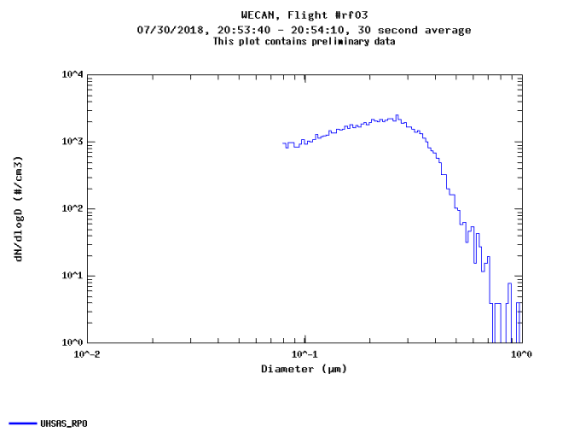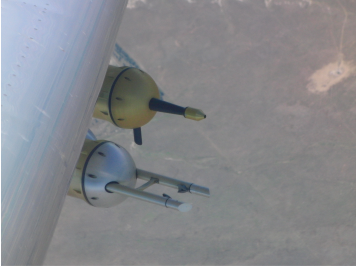Ultra-High Sensitivity Aerosol Spectrometer
UHSAS-G
The UHSAS-G, the rack or 'ground' version of the probe, is manufactured by Droplet Measurement Technologies, Inc. It measures the size-resolved concentration of aerosol particles in 99 bins spanning 55 - 1000 nm. Because it is designed as a benchtop instrument, its flow system has been modified by RAF to handle pressure variations in flight. This included the addition of a flow controller in the sheath circuit, and a custom-built laminar flow element (LFE) flowmeter to capture sample flow variations not seen by the sample flow controller placed on the flow system's exhaust.
UHSAS-A***The UHSAS-A is no longer requestable***
Photo of the UHSAS-A (top instrument) mounted next to a 2DC probe on the GV research aircraft:
The UHSAS-A (wing model) was originally manufactured by Particle Metrics, Inc., then by Droplet Measurement Technologies until recently, but is no longer produced. It measures the concentration and size distribution of aerosol particles having diameters from 0.060 --1.0 µm, in 99 bins that are approximately logarithmically spaced. The instrument flies in an under-wing canister and senses particles in the airstream via light scattering from individual particles. The maximum counting rate for which coincidence error may be neglected is about 3000/s, so the maximum concentration (at a sample rate of about 0.83 volume cm3/s) is about 3600 cm-3. Flow is maintained by a volumetric flow controller, and concentrations are reported in the data files at ambient (not instrument) conditions. Data at 10 Hz are transferred via RS-422 to the aircraft data system and recorded there, and are optionally recorded on the laptop as well.
The instrument is specified to operate at temperatures > -40°C and altitudes < 12 km. The altitude ceiling is conservative, based on a legacy spec for the sample flow controller, and the probe can in fact operate to the ceiling of the GV, or nearly 15 km. There have been some operational problems at higher altitude and lower temperature, notably noise in the first channels. These have been improved, though not entirely eliminated, through modifications to the instrument. Small-diameter noise in particular continues to be a problem, requiring blanking of data at times, and/or elimination of the first few diameter channels for an entire project data set. The probe covers the full size range through the use of two different detectors, each having two gain circuits, and there is some overlap among the sensitive regions of these four channels so the instrument must choose the best signal for each size pulse. The relative gains can shift slightly during flight, so at times gaps or discontinuities appear in the size distributions. This also was addressed in the earlier changes, and stability is much improved.
The UHSAS-A must receive an initialization record, which can come from a host laptop PC with a LabView application, or from a static record sent by a Data System Module (DSM). The instrument fits in a standard 6" instrument wing pod.
Model: DMT UHSAS-A (airborne)
Measurements Provided: Aerosol size distribution and concentration, 60 - 1000 nm diameter
Typical Sampling Rates: 10 Hz
Example(s) of Measurement:
A UHSAS-A differential size distribution from an ARISTO-2016 flight:

Two differential size distributions from a WE-CAN flight:

